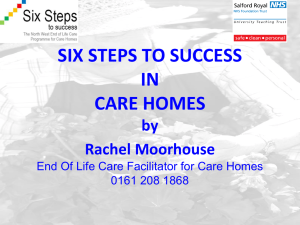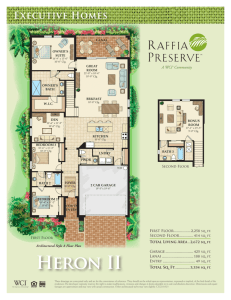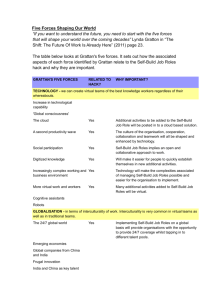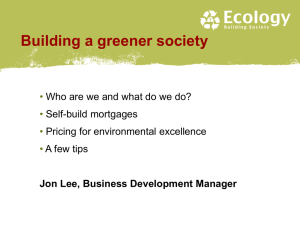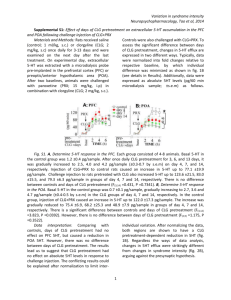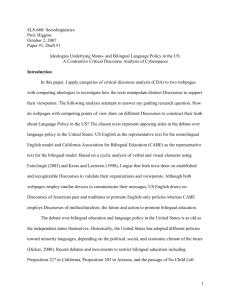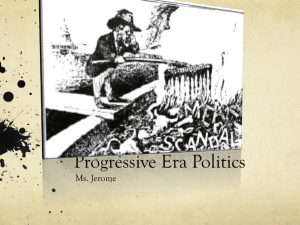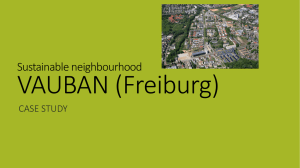Stephen Hill - Co-operative Housing International
advertisement
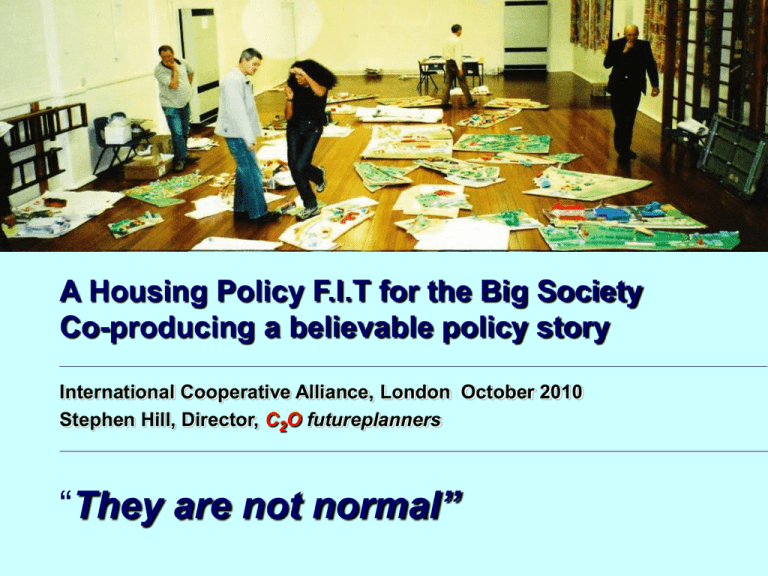
A Housing Policy F.I.T for the Big Society Co-producing a believable policy story International Cooperative Alliance, London October 2010 Stephen Hill, Director, C2O futureplanners “They are not normal” The Big Picture Story… The Big Society and Open Source Planning “Too much has been imposed from above, when experience shows that success depends on communities themselves having the power and taking the responsibility. It’s no good officials in Whitehall or even the Town Hall telling people what is needed in their street.” …. everyone has a stake based on equal rights and where they pay their dues by exercising responsibility in return, and where local communities shape their own futures. Letter to the Editor Prescott’s ‘growth areas’ pull plans for thousands of homes Building Magazine 6/08/10 “Dear Sir, The ‘big society’ is working well, then. Up and down the land, local communities have overwhelmingly agreed they don’t want any new neighbours. Yours etc” MP for Tunbridge Wells (Disgusted of Tunbridge Wells? ) “It’s a very miserable view of human nature, that people who are not told what to do, default to something that is short term, individually selfish, and unenlightened.” Greg Clark, Minister for Planning and Decentralisation, Guardian Interview 15/9/10 600 home scheme in Tonbridge Wells turned down to protect the dormice Housing Policy for a Big Society We need a shared vision of what housing is for in the life of the country …but what housing policy? Purpose & Process of co-production • “We will be hosting public meetings to engage with individuals, those active in civil society and social entrepreneurs on all aspects of the big society, but in particular how the network can best support individuals to come together in groups at local level.” Big Society Network invitation [Network staff=6 civil servants] • “If we can answer this, then it is possible to genuinely allow communities to have more involvement.” Greg Clark interview The story of community housing… as told by the normal people • More expensive than…? • More risky than…? • More complicated than…? • Difficult people…? • Difficult schemes…? Quite probably, because they want to do more than…. NORMAL Some not normal schemes: Models for bottom up housing and open source planning “At last, it’s not Vauban” Smiley West, Karlsruhe A grown up politics of design …secure by living together “Managing our co-existence in shared space” Prof. Patsy Healey – Definition of Spatial Planning “The innovation in German urbanism in the last decade” Coop Mika, Karlsruhe Diversity and maturity in mainstream politics and housing markets - Germany Tübingen Südstadt Hamburg, Leipzig…. Project Vauban, Freiberg The Tübingen way… Co-production of shared space The English way…space as commodity Trust… in the design code… At Vauban…this is all there is …and co-production through dialogue How many pages does your Design Code have? Alternative public practice • Pelham Grove Coop N17 • The Game>>Planning for Real • Brief: “not look like a council house” 40 years onSanford Coop, Railway Cuttings, Lewisham… 60% cut in CO2 Argyle Street Coop Cambridge Half Moon Crescent TMC LB Islington Wesley Square Co-ownership, North Kensington Community and Private Self-build The Diggers, Brighton • “ a microcosm of what could be achieved on other sites all over the country by harnessing the imagination and skills of ordinary people.” • “that indefinable quality which marks out the outstanding from the excellent DETR Housing Design Award citation 1998 Sussex Road, London N19 1999 Old people look after themselves… HAPPIer and cheaper than the council Tenant Management Coop 355 Queensbridge Rd Springhill Co-housing Stroud, UK “Weirdy…they are not normal.” Ward Councillor (from the Big Society Party) at Planning Committee Threshold Centre, Dorset First HCA grant funded mixed tenure co-housing Shared facilities include: • The stone farmhouse for visiting guests, and shared meals • 1 acre community market garden • Laundry • Car pool Commitments for all residents: • 4 hours per week of unpaid time to help look after the shared facilities, and do cooking • 1 car and 1 pet per household • Paying share of the running costs of shared facilities • Before taking up residence, spending up to 4 nights here, for the new resident and community to get to know each other. Hearthstone Cohousing N. Denver, Colorado 33 leasehold houses and flats with a 4,800 sq. ft. common house on a 1.6 acre site. The community was first phase of a ‘new urbanist’ redevelopment in the historic North Denver neighbourhood. Commercial and political good sense • Attracting a particular kind of resident, where the market may be weak, but opportunity is rare • Reducing risk through presales and pre-allocations • Preserving affordability in perpetuity • Living marketing - new residents actively occupying early phases • Stewardship committed to the long term success of the place • Increasing and retaining value within neighbourhood for the benefit of residents and investors. Wick Village TMC, Hackney Spatial Planning &Placeshaping Outcomes • Community membership and ownership • All incomes and tenures • Medium and high density • Value for money • Long term stewardship • Life in the space between the buildings • Social Capital for the care of the place and people • Resident satisfaction and wellbeing • Sustainable living and resilience through social organisation …social cohesion??? Ye Olde Placeshapynge and Spatial Plannyng… “The exceptional urban and environmental qualities we esteem in many of our older cities were achieved with a very modest input of resources, and by a careful and evolving response to the needs of their inhabitants.” Ralph Erskine, Architect Social Housing Provider of the Year 2004 Public Interest Design Code 143 pages “It’s like Beirut…” Germaine Greer in the Guardian, September 2009 “…uniformly depressing” Another developer A Prize-winning street? What are these spaces for? Who will be responsible? Maintenance? Workmanship? Design? Who will decide? A. “The Resident Management Company” Coproduction needs new ideas about… • Skills and Competence • Control and Accountability • Scale • Self-help • Commercial • Social Enterprise • Mixed economy http://www.youtube.com/watch?v=yjrIVjSK6oA SPAN Housing – Blackheath The Ralph Erskine Test of time, and skills and ideas we have lost The Hall and Hallgate, Blackheath 1957 The trouble with planners is… The Architect in Society, Keith Godwin SPAN Housing at Corner Green… …50 years on “My particular interest was the formation of the courtyard which I thought was a dead space. [It] is not a dead space. It is actually circulation” Eric Lyons “Resident-controlled management companies may sound dully utilitarian, but have been crucial to their success.” Tony Aldous, former resident and architectural writer Failure of top-down planning and housing • Impoverished design and quality of place • Unrealistic expectations of house builders as placeshapers • Planning as remote…control‘Too big, too dense and too near me… not for us or with us’ • Affordability permanently lost • Central housing targets are not spatial planning • Democratic deficit Key planning and housing policies for the Localism Bill Community Rights to: • Build… rural first, and extend to urban • Buy… public first, maybe private assets • Plan… CRtBs X 2 & Neighbourhood Plans • Bid… for public sector functions The Minister’s Story… “We will become a nation of homebuilders” • A rural housing revolution… Local Housing Trusts will give people the power to expand their villages up to 10% over 10 years. - Accommodation for the old - Affordable homes for the young - Shops, schools, GP surgeries • People at last really shaping their own communities • Power to bypass planning committees • But I don’t want the principles of Local Housing Trusts just to be a countryside thing. Our towns and inner-cities must benefit too. “We’ve been through the highs and lows together” Charlie Hibbert, CLT Member “I am really impressed by the foresight and tenacity of local people in driving this scheme forward. Seeing these houses here, built to high standards by the owners, with the support of professionals is most impressive.” Grant Shapps, Shadow Minister 2008 The model for Local Housing Trusts… Cornwall CLT Programme 2007 17 villages – 120+ homes Unique partnerships… enabling district councils, their communities, Carnegie UK Trust, and an RSL Blisland CLT on Bodmin Moor St. Minver CLT Average house price Market value Cost including land 12 houses 12 months On time – On budget £650,000 £350,000 £120,000 A social movement or more effective PPS 3 compliance for affordability in perpetuity ??? Charlie’s Story… Living Ricardo’s Law of Economic Rent Land Development Study 1980-88 From Prof. Peter Ambrose “Urban Process and Power” (Routledge 1994) M-Way Corridor A v. M-Way Corridor B • Total No. Homes per 1000 people: • Affordable Homes: • Choice of tenure/production: 7.3 v. 6.1 65% v.15% 5 v. 2 38% LA rent- 27%Coop- 43% Owned [50% self-build] - 2% market rent. Variations reflect local political preferences 85% Owned [0% self-build] 15% social rent Tenure determined by central government policy Affordable dropped to 6% just after study period • Professional/managerial in ‘social’: 49% v.<2% E4 Corridor Stockholm-Uppsala v. M4 Corridor Berkshire • Building cost increase: 24% v. 47% Extended period of capitalisation & innovation in construction efficiency and productivity • Land price increase: • Land as % of house price: <5% v. 436% +/-10% v. 60% • Market impacts on supply post-’88: +/- 0% v. -60% • Land differential/hectare: £301k/ha v. £1,222k/ha E4 = M4 4 Why Land Price is the issue The costs of complying with public policy and regulation ie. the essential basic requirements of Spatial Planning, to create sustainable places and communities: Dwelling size and quality Affordability of all housing Climate Change Adaptation/Resilience Progress to Zero CO2 Hard and Soft Infrastructure should be internalised and reflected in land price and valuation… but aren’t! The Business Case • Costs of primary health care, mental health, policing, education lower in areas of better quality housing • Factor difference 5-7 times • Even if 50% wrong = big number • Size difference 25% Recognised in RICS, BRE, CABE, IDEA Housing Corporation and EP guides and tools A Principled Housing Policy Sufficient support for… • 1. Plausibility: The price of a modern home and sufficient space will be within the means of a family/household with an average income. • 2. Neutrality: There should be similarity of pricing between equivalent homes in different forms of tenure • 3. Social: The position of disadvantaged groups in the housing market will be strengthened. • 4. Standards: Housing consumption for all should be supported upto a certain standard. Consumption beyond the standard not to be supported through public action and funds. • 5. Parity: Differences of price between homes of different ages and condition will correspond with differences in their utility value. • 6. Speculation: Explicit action is needed to counteract the inflationary transfer of wealth to property owners. Courtesy Prof. Peter Ambrose Access to land • Deliver pre-election Cabinet Office requirement for small sites [<50 homes] for coops and mutuals in HCA Public Land Initiative • Extend to all public land, and include schemes <50 homes in larger public sites, as CNT used to do • Extend to all land through site or locality specific outcome driven spatial planning policies ‘Garden grabbing’ SPAN Housing Corner Green, Blackheath 1956 A welcome route out of market failure? The ‘Coops and Mutuals’ demand-side self-organising housing sector body • Commission for Cooperative and Mutual Housing • National Community Land Trust Board (CLG Community Empowerment Fund - Carnegie UK Trust and National Housing Federation) • Confederation of Cooperative Housing • UK Cohousing Network • National Self Build Association • Development Trusts Association • Cooperatives UK • Community Gateway Associations The Coops’ and Mutuals’ self-organising story The Actions: • Feeding into CLG policy development on Community Rightto-Buy and Build • Working with CLG Housing Construction Roundtable on supply side measures, coordinated by RICS • Co-producing with the HCA on its community housing advice initiative • Developing proposals for Communities Direct and a national action learning network The Offer: • Wellbeing outcomes that will be a material consideration • Social organisation as a tool for the adoption of sustainable life choices, particularly mutual support in old age • Co-operative partners and a role with LSPs and HCA as local placeshapers Communities Direct: Unlocking economic & social capital • Capital Funding …developing a market: development finance, mortgage products, guarantees, revolving funds and grant, capacity to unlock private debt and equity finance, harmonisation of public and private financial instruments. • Legal clarity ….model forms of organisation, leasehold and staircasing rules, model legal agreements, planning agreements, harmonisation with financial arrangements. • Revenue Funding …seed corn resources for enabling, capacity building, supporting the growth of the sector, [historical precedent for the ‘flower pot men’ who grew the housing association movement after the 1974 recession], policy development and action learning; better value for money transaction costs • Realism …about what can be done effectively on a voluntary basis and without organisational development of individual trusts and support bodies. Look at what the Scots are doing… The RICS’ story Advice • Spatial Planning & Delivery (2009) Valuation Guidance • Land for Affordable Housing (6/10) • Council Assets Less than best (2/11) • Development Land (2011?) Research • Land Value Taxation (12/10) Policy • Taylor Report on Rural Housing and access to land • Champion for sector in CLG Housing Construction Roundtable and Housing Sounding Board • Thinkpieces to CLG Ministers and officers on community rights and strategic planning • Commission on Community Assets The Royal Charter 1881 Objects To maintain and promote the usefulness of the profession for the public advantage in the United Kingdom and in any other part of the world …securing the optimal use of land and its associated resources to meet social and economic needs More than… a rural revolution The Self-Organisers… Community Land Trusts, Co-Housing, Co-ops, self-build, self-commissioned “Time for a citizens’ housing revolution …creating democratic places” http://www.cabe.org.uk/ publications/who-should-build-our-homes CABE Community Housing Support Unit Community led housing design programme to 31/3/11: • CABE and CLG Housing Supply, collaborating to support this increasingly important sector and what it can contribute to placeshaping. • CABE is working with existing groups and networks to provide direct support to a small (4) number of schemes. • CABE is focussing on client support, agreeing a vision, briefing, appointing consultants, evaluating proposals and procurement strategies. • CABE is working with existing networks to share the learning and best practice emerging from these schemes Sam McCauley and Dominic O’Neill - Housing Advisors SMccauley@cabe.org.uk and doneill@cabe.org.uk The Wise Words of Sir Bob… • “Put simply, we want to make the programmes fit the place, rather than adapting places to fit programmes.” • “We’re seeking to instigate a holistic approach to placemaking that embeds design, sustainability and community engagement in the process of setting investment priorities and ambitions.” Rudi.net online interview 23/2/10 Juliana O’Rourke Slightly less wise words from Eric • Council Planning Departments are “the last bastion of communism and sheer bloody mindedness” • “In a climate of low or non-existent Whitehall grants, it would be a very foolish council indeed… to ignore the opportunity of generating cash from house building” • Local authorities would be able to accumulate significant sums of money” [25p per home plus Council Tax for 6 years]… • "There has been no planning for 40 years. We just have development control, not planning…predicated on conflict and the mighty winning." A new ‘Big Society’? A true common wealth • Everyone talks of freedom, but there are few that act for freedom, and the actors for freedom are oppressed by the talkers and verbal professors of freedom: if thou wouldst what true freedom is, thou shalt see it lies in the community of spirit and the community in the earlthly treasury” Gerrard Winstanley, Leader of the Diggers 1649. A new ‘Big Society’? Private action for social advance • “(The) abundance of voluntary action outside one’s home – individually and in association with other citizens – for bettering one’s own life and that of one’s fellows are the distinguishing marks of a free society. They have been outstanding features of British life.” • “Scratch a pessimist and you find often a defender of privilege.” William Beveridge, Voluntary Action 1948 ‘The Death and Life of Great American Cities’ Jane Jacobs “Cities have the capability of providing something for everybody, only because and only when, they are created by EVERYBODY.” FITS for Purpose and Process • Freedom for the ‘not normal’ people • Financially Intelligent • Inclusive • Transparent • Simple futureplanners Our principles of public interest practice: • Share a commitment to help create sustainable and democratic places • Come from the traditional professional institutions and none • Believe in value driven work for sustainable development • Promote ourselves to work with value driven clients, and • Share learning and innovation with others stephenhill@futureplanners.net

